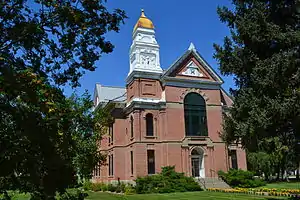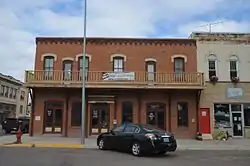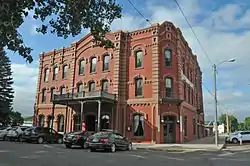Fort Benton, Montana
Fort Benton is a city in and the county seat of Chouteau County, Montana, United States.[4] Established in 1846, Fort Benton is the oldest settlement in Montana. The city's waterfront area, the most important aspect of its 19th-century growth, was designated the Fort Benton Historic District, a National Historic Landmark, in 1961.
Fort Benton | |
|---|---|
 Chouteau County Courthouse | |
| Nickname(s): "The Birth Place Of Montana" | |
 Location of Fort Benton, Montana | |
| Coordinates: 47°49′10″N 110°40′11″W | |
| Country | United States |
| State | Montana |
| County | Chouteau |
| Area | |
| • Total | 2.29 sq mi (5.94 km2) |
| • Land | 2.29 sq mi (5.94 km2) |
| • Water | 0.00 sq mi (0.00 km2) |
| Elevation | 2,621 ft (799 m) |
| Population | |
| • Total | 1,464 |
| • Estimate (2019)[3] | 1,432 |
| • Density | 624.51/sq mi (241.11/km2) |
| Time zone | UTC-7 (Mountain (MST)) |
| • Summer (DST) | UTC-6 (MDT) |
| ZIP code | 59442 |
| Area code(s) | 406 |
| FIPS code | 30-28000 |
| GNIS feature ID | 1750122 |
| Website | www.fortbenton.com |
The population was 1,464 at the 2010 census.
History
Established in 1846 by Alexander Culbertson, who worked for Auguste Chouteau and Pierre Chouteau, Jr. of St. Louis, the original Fort was the last fur trading post on the Upper Missouri River,[5][6] the fort became an important economic center. For 30 years, the port attracted steamboats carrying goods, merchants, gold miners and settlers, coming from New Orleans, Memphis, St. Louis, Hannibal, Bismarck, Kansas City, etc.[5] As the terminus for the 642-mile-long Mullan Road, completed by the United States Army in 1860, and at the head of navigation of the Missouri River, Fort Benton was part of the overland link between trade on the Missouri and the Columbia River, at Fort Walla Walla, Washington. Twenty thousand migrants used the road in the first year to travel to the Northwest. It became an important route for miners from both directions going into the interior of Idaho,[7][8] and north to Canada.[9] Steamboat travel to Fort Benton from St. Louis, Missouri helped broadly fuel the development of the American West between 1860 and 1890, when it was supplanted by railroad transport. The river was an important route for miners to the newly discovered gold fields of southern Montana at what became Bannack and Virginia City beginning in 1862, and Helena, beginning in 1865.
With the decline of the fur trade, the American Fur Company sold the fort to the Northwest Fur Company in 1865, and the fort became a U.S. Army post from 1868 until the army units departed in 1881. Founder Alexander Culbertson formally named it Fort Benton on Christmas Day 1850, in honor of Missouri Senator Thomas Hart Benton[10] of Missouri. Beginning in the early 1860s, with the arrival of the first steamboats, a town began to grow up around the fort. Besides being one of the most important ports on the Missouri-Mississippi river system, Fort Benton was once the "World's Innermost Port" - the furthest point of navigable water on the Missouri River.[8] It was served by numerous well-known "mountain boats" (designed for the Missouri River), including the Yellowstone and the Far West, and their famed captains, Joseph LaBarge and Grant Marsh, respectively.[11][12][13]
Fort Benton's importance in trade was superseded by the construction of transcontinental railroads in the late 19th century. In 1867, Fort Benton was the site where Union General Thomas Francis Meagher, then acting governor of Montana Territory, fell overboard from his steamboat and drowned in the river; his body was never recovered. On July 5, 1988 the Fort Benton area was struck by an F3 tornado that injured two people.[14]
Native American civil rights abuse
In 1869, Mountain Chief, then Chief of the Pikuni Blackfeet Indians, travelled to the town of Fort Benton to request the agent of his reservation to remove illegal whiskey traders from Blackfeet land. The chief was physically assaulted by a gang of white residents.[15][16] In the same year, Mountain Chief's brother and a teenage boy were assassinated in Fort Benton, supposedly in retaliation for the death of a white cattle rancher near to the town.[17] In both cases, officials neglected to file criminal charges on behalf of these three Blackfeet Indians. In 1870, a group of 10 Blackfeet Indians would be killed by Fort Benton soldiers and vigilantes for the alleged crime of cattle raiding.[15]
Geography

Fort Benton is located at 47°49′10″N 110°40′11″W (47.819307, -110.669726).[18]
According to the United States Census Bureau, the city has a total area of 2.07 square miles (5.36 km2), all land.[19]
The community sits in a narrow river valley on the west bank of the Missouri River and is in a geographic area known as the Golden Triangle (one of several dozen folk regions of Montana) due to the strength of the wheat industry of the region. For example, in 2007, Chouteau County was one of two counties in the United States with the highest wheat production. The long summer days (due to being at almost 48 degrees N latitude) and fertile soil of the area (due in part to ash deposits from the Elkhorn Volcanics to the south) leads to exceptionally "hard" wheat (high protein content) thriving in the area.
Fort Benton experiences a semi-arid climate (Köppen BSk) with cold, dry winters and hot, wetter summers.
| Climate data for Fort Benton, Montana | |||||||||||||
|---|---|---|---|---|---|---|---|---|---|---|---|---|---|
| Month | Jan | Feb | Mar | Apr | May | Jun | Jul | Aug | Sep | Oct | Nov | Dec | Year |
| Record high °F (°C) | 71 (22) |
77 (25) |
83 (28) |
93 (34) |
97 (36) |
104 (40) |
106 (41) |
109 (43) |
100 (38) |
94 (34) |
79 (26) |
67 (19) |
109 (43) |
| Average high °F (°C) | 35.1 (1.7) |
41.4 (5.2) |
51.1 (10.6) |
62.8 (17.1) |
71.8 (22.1) |
79.3 (26.3) |
86.6 (30.3) |
85.8 (29.9) |
75.4 (24.1) |
64.3 (17.9) |
46.6 (8.1) |
37.3 (2.9) |
61.5 (16.3) |
| Daily mean °F (°C) | 22.6 (−5.2) |
28.1 (−2.2) |
37.2 (2.9) |
47.4 (8.6) |
56.6 (13.7) |
64.1 (17.8) |
69.6 (20.9) |
68.8 (20.4) |
58.6 (14.8) |
48.4 (9.1) |
33.9 (1.1) |
25.3 (−3.7) |
46.7 (8.2) |
| Average low °F (°C) | 10.1 (−12.2) |
14.7 (−9.6) |
23.3 (−4.8) |
32.0 (0.0) |
41.3 (5.2) |
48.8 (9.3) |
52.6 (11.4) |
51.7 (10.9) |
41.7 (5.4) |
32.4 (0.2) |
21.2 (−6.0) |
13.2 (−10.4) |
31.9 (0.0) |
| Record low °F (°C) | −49 (−45) |
−37 (−38) |
−35 (−37) |
−8 (−22) |
16 (−9) |
30 (−1) |
35 (2) |
29 (−2) |
17 (−8) |
−15 (−26) |
−29 (−34) |
−47 (−44) |
−49 (−45) |
| Average precipitation inches (mm) | 0.55 (14) |
0.39 (9.9) |
0.85 (22) |
1.21 (31) |
2.30 (58) |
2.45 (62) |
1.33 (34) |
1.52 (39) |
1.23 (31) |
0.80 (20) |
0.54 (14) |
0.52 (13) |
13.69 (347.9) |
| Source 1: NOAA (normals, 1971–2000) [20] | |||||||||||||
| Source 2: The Weather Channel (Records) [21] | |||||||||||||
Demographics
| Historical population | |||
|---|---|---|---|
| Census | Pop. | %± | |
| 1880 | 1,618 | — | |
| 1890 | 624 | −61.4% | |
| 1900 | 1,024 | 64.1% | |
| 1910 | 1,004 | −2.0% | |
| 1920 | 1,065 | 6.1% | |
| 1930 | 1,109 | 4.1% | |
| 1940 | 1,227 | 10.6% | |
| 1950 | 1,522 | 24.0% | |
| 1960 | 1,887 | 24.0% | |
| 1970 | 1,863 | −1.3% | |
| 1980 | 1,693 | −9.1% | |
| 1990 | 1,660 | −1.9% | |
| 2000 | 1,594 | −4.0% | |
| 2010 | 1,464 | −8.2% | |
| 2019 (est.) | 1,432 | [3] | −2.2% |
| U.S. Decennial Census[22][23] | |||
Fort Benton | |
 | |
  | |
| Location | Fort Benton, Montana |
|---|---|
| Built | 1846 |
| NRHP reference No. | 66000431 |
| Significant dates | |
| Added to NRHP | October 15, 1966[24] |
| Designated NHLD | November 15, 1961[25] |
2010 census
As of the census[2] of 2010, there were 1,464 people, 686 households, and 412 families residing in the city. The population density was 707.2 inhabitants per square mile (273.1/km2). There were 811 housing units at an average density of 391.8 per square mile (151.3/km2). The racial makeup of the city was 97.4% White, 0.1% African American, 0.5% Native American, 0.2% Asian, 0.1% from other races, and 1.7% from two or more races. Hispanic or Latino of any race were 0.6% of the population.
There were 686 households, of which 20.8% had children under the age of 18 living with them, 48.3% were married couples living together, 7.6% had a female householder with no husband present, 4.2% had a male householder with no wife present, and 39.9% were non-families. 37.0% of all households were made up of individuals, and 18.6% had someone living alone who was 65 years of age or older. The average household size was 2.08 and the average family size was 2.67.
The median age in the city was 52.1 years. 17.6% of residents were under the age of 18; 5.1% were between the ages of 18 and 24; 17% were from 25 to 44; 32.7% were from 45 to 64; and 27.7% were 65 years of age or older. The gender makeup of the city was 47.5% male and 52.5% female.
2000 census

As of the census[26] of 2000, there were 1,594 people, 636 households, and 422 families residing in the city. The population density was 763.2 people per square mile (294.5/km2). There were 731 housing units at an average density of 350.0 per square mile (135.0/km2). The racial makeup of the city was 97.68% White, 0.19% African American, 0.56% Native American, 0.38% Asian, 0.38% from other races, and 0.82% from two or more races. Hispanic or Latino of any race were 0.56% of the population.
There were 636 households, out of which 30.7% had children under the age of 18 living with them, 54.4% were married couples living together, 9.3% had a female householder with no husband present, and 33.5% were non-families. 31.0% of all households were made up of individuals, and 14.5% had someone living alone who was 65 years of age or older. The average household size was 2.34 and the average family size was 2.93.
In the city, the population was spread out, with 24.8% under the age of 18, 6.2% from 18 to 24, 23.1% from 25 to 44, 22.3% from 45 to 64, and 23.6% who were 65 years of age or older. The median age was 43 years. For every 100 females, there were 92.3 males. For every 100 females age 18 and over, there were 84.2 males.
The median income for a household in the city was $29,406, and the median income for a family was $32,072. Males had a median income of $22,813 versus $20,787 for females. The per capita income for the city was $14,861. About 11.6% of families and 13.4% of the population were below the poverty line, including 16.6% of those under age 18 and 6.7% of those age 65 or over.
Media
Fort Benton is home to radio station KYPZ.
Notable people
| Wikimedia Commons has media related to Fort Benton, Montana. |
- Denise Curry, basketball player and coach.
- Charles S. Hartman, United States Congressman.
- William Henry Hunt, state and federal judge, and governor of Puerto Rico.
- Daniel Webster Marsh, mayor of Calgary, Alberta.
- Charles Nelson Pray, United States Congressman.
- U.S. Grant Sharp, Jr., four-star admiral and Commander-in-Chief of the United States Pacific Fleet
- Eleanor Dumont (1834-1879), also known as Madame Moustache, professional card dealer and gambler
See also
- Shep, dog who famously waited for his owner in Fort Benton
References
- "2019 U.S. Gazetteer Files". United States Census Bureau. Retrieved July 26, 2020.
- "U.S. Census website". United States Census Bureau. Retrieved 2012-12-18.
- "Population and Housing Unit Estimates". United States Census Bureau. May 24, 2020. Retrieved May 27, 2020.
- "Find a County". National Association of Counties. Archived from the original on 2011-05-31. Retrieved 2011-06-07.
- Chouteau County Courthouse, 2009
- Fort Benton Restoration Committee, 2019
- "Mining and the Mullan Military Road", The Mullan Project, Eastern Washington State University, accessed 26 Oct 2009
- Fort Benton, Official City website, accessed 26 Oct 2009
- Ward, Tom (1975). Cowtown : an album of early Calgary. Calgary: City of Calgary Electric System, McClelland and Stewart West. p. 220. ISBN 0-7712-1012-4.
- Gannett, Henry (1905). The Origin of Certain Place Names in the United States. Govt. Print. Off. pp. 128.
- "Last of the Argonauts: The Life and Services of Capt. Grant Marsh," Sioux City Journal, p. 10, January 16, 1916, Sioux City, Iowa.
- "Stirring Times of 80's Recalled in Article on Capt. Grant Marsh," Bismarck Tribune, p. 4, July 11, 1914, Bismarck, North Dakota.
- Chittenden, 1903, Volume I, pp. 217-218
- http://www.homefacts.com/tornadoes/Montana/Chouteau-County/Fort-Benton.html
- Wissler, Clark (2 January 2013). Amskapi Pikuni: The Blackfeet People. SUNY Press. p. 86. ISBN 143844334X.
- Garraty, John; Carnes, Mark (1 January 1999). American National Biography (16 ed.). Oxford University Press. p. 36.
- Hanchett, Leland (2008). Montana's Benton Road. Wolf Creek, Montana: Pine Rim Publishing. p. 84. ISBN 978-0963778598.
- "US Gazetteer files: 2010, 2000, and 1990". United States Census Bureau. 2011-02-12. Retrieved 2011-04-23.
- "US Gazetteer files 2010". United States Census Bureau. Archived from the original on 2012-07-02. Retrieved 2012-12-18.
- "Climatography of the United States NO.81" (PDF). National Oceanic and Atmospheric Administration. Retrieved January 15, 2011.
- "Monthly Averages for Fort Benton, MT". The Weather Channel. Retrieved January 15, 2011.
- "Census of Population and Housing". Census.gov. Retrieved June 4, 2015.
- "Census & Economic Information Center". Retrieved July 3, 2015.
- "National Register Information System". National Register of Historic Places. National Park Service. January 23, 2007.
- "Fort Benton". National Historic Landmark summary listing. National Park Service. Archived from the original on 2008-04-13. Retrieved 2008-07-15.
- "U.S. Census website". United States Census Bureau. Retrieved 2008-01-31.
Sources
- Chittenden, Hiram Martin (1903). History of early steamboat navigation on the Missouri River : life and adventures of Joseph La Barge, Volume I . New York : Francis P. Harper.
- "The History of Old Fort Benton". Fort Benton Restoration Committee. Retrieved October 26, 2009.
- "Welcome to Chouteau County, Montana". Chouteau County Courthouse. Retrieved October 26, 2009.
